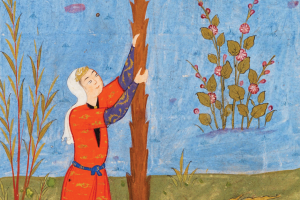When it comes to enemies, we rarely think twice. Our response is emotional and reflexive. If something comes from them, we’re against it. Whatever it is they’re saying, it’s wrong. Whatever they want is bad. Whatever they’re doing must be stopped.
We carry this attitude forward to our nation’s formal opponents as well as to rivals at work, political adversaries, neighbors who bug us, and family members who press our buttons. Nothing these people are up to can be good. It would help if they would just disappear.
In biblical times, that mindset pretty much sums up the relationship between Jews and Samaritans. The tension between these groups is so pervasive in both Testaments that it may not occur to us to ask: What’s up with Samaritans, anyway? Why are they so hated?
To understand why people despise one another always requires a backstory. From the Israelites’ entry into Canaan to the generation of Jesus, the biblical saga centers on a smattering of tribes living on a thread of land from Galilee to the Dead Sea. We call this place Israel and imagine 12 tribes bonded in kinship and loyalty—but scratch that notion.
Israel’s first king, Saul, only governs some of these people. His successor, David, pulls all the tribes together under him. David’s son, Solomon, does little to hold them in place. When Solomon dies in 930 B.C.E., the kingdom fractures into big northern Israel and meager southern Judah. The north names its capital Samaria. The southern kings retain David’s capital at Jerusalem.
As scholar Raymond Brown points out, the distance between Samaria and Jerusalem was 35 miles—closer than Baltimore and Washington, D.C., which share an airport. But proximity doesn’t equal intimacy.
Eventually, Samaria becomes a catchword for the entire northern region. Neither the city nor the region known as Samaria denotes the land of “Samaritans,” however. They come later. Meanwhile, for 200 years skirmishes ensue between the north and south, with tiny episodes of cooperation.
Keep in mind, the folks on both sides of the border claim Abraham as father and Moses as liberator. They all worship the God of Jacob. They’re all children of Israel. Initially, their differences are political. But they become cultural too, as time apart renders these two kingdoms increasingly estranged.
Back when Israel was a single nation, King David established Jerusalem as the political and religious center. Solomon built the magnificent Temple there. After the kingdom fractures, Judah has the Temple. Where will northern Israelites worship now?
Their first king, Jeroboam, establishes worship centers at Bethel and Dan with a splendid golden calf at each site. The calf represents the seat of God—which is just what the ark of the covenant in Jerusalem was understood to be. Of course, the calf also reminds us of a sorry story of idolatry in Exodus. Naturally, the Judeans accuse the northerners of worshipping golden statues. In fact, Judeans don’t have anything nice to say about the folks up north, and since Judeans write most of the Bible as we have it, it’s hard to know if their criticisms are accurate or exaggerated. This is the problem with having enemies: After a while, it’s hard to know where objectivity ends and hate takes over.
Into the story comes the evil empire of Assyria. On this characterization we can rely, since historical records of the period detail Assyrian atrocities. By 722 B.C.E., Assyria swallows the northern kingdom of Israel, deporting 27,290 people from Samaria to far-flung places. The “10 lost tribes of Israel” officially get lost here as the northern tribes disperse. In their place, Assyria seeds the territory with Babylonians and other Mesopotamian people. Assyrians break the will of conquered societies this way, erasing their identity, culture, and religion.
To the south, Judah watches the devastation of its northern rival—remember, Jerusalem is only 35 miles away. There’s not much breathing room to gloat. A century later, Assyria’s power wanes, and Babylon ascends as the new regional superpower. Babylon crushes Jerusalem in 587 B.C.E., dragging all the best people into exile.
So what happens while the Judeans are in exile? People migrate. Jerusalem is a wreck, to be sure, but there are lots of useful parts lying around. When the Judeans in Babylon are finally liberated by the Persians in 538 B.C.E., those who still care about Jerusalem return to find people living in the region. They despise these “Samaritans.” What’s worse, the returnees from exile are made subordinate to the now Persian province of Samaria. The contest for control between Judea and Samaria is back on.
Some scholars say Samaritans were probably Israelites from Samaria who spread out over the territory while the Judeans were gone. Some say Samaritans weren’t Israelites but descendants of the Mesopotamians—foreigners—seeded onto the land by Assyria. Others describe Samaritans as descendants of Judeans who didn’t go into exile with the rest—because they’d run away and come back after the danger had passed. Or because they weren’t skilled or educated enough to be of use to Babylon and so were left behind. In any event, the non-exiles didn’t suffer with their kinfolk and didn’t deserve to be counted among them.
What’s certain is that these “people on the land” were strange. They didn’t perform the religious rituals correctly and had all sorts of incompatible ideas about God. Samaritans considered northern Mount Gerizim to be holier than Jerusalem’s Mount Zion. They recognized only the five books of Moses—Genesis through Deuteronomy—as their scripture. Returnees from Babylon had composed books of history and collected prophecies to add to their holy books. Some of their prophets—Amos, Isaiah, Hosea, Ezekiel, and Micah—had nothing good to say about people from Samaria.
Judean leaders tried to resolve the conflict. The priest Ezra thought there could be reconciliation between these two societies. But the governor Zerubbabel took a racist approach: Their blood is impure. They’re simply “not us.” Verbal disputes led to insults, insults to violence.
The communities separate. Samaritans centralize in the northern area of Shechem. As Greek control of the land succeeds Persian, then Egyptian, and finally Roman, the region of Samaria becomes increasingly Hellenized; that is, more like the empire. Judeans resist outside influences at all cost. By the first century C.E., the worst thing you can call a Jew is a Samaritan—which is what Jesus’ detractors call him in John’s gospel.
How daring, then, for Jesus to tell a story about a good Samaritan! To share an extended conversation with a Samaritan woman he meets at a well, then to welcome her whole community as they seek an encounter with him. Citizens of Judea had spent centuries walling Samaritans out of their society with laws and mistreatment. Jesus raises the possibility that it’s time to admit these outsiders. A thousand years of bickering and division, perhaps, is enough. When the first-generation church sends Philip to evangelize in Samaria, it’s a bold and shattering proposition. And it results in “great joy in that city” (Acts 8:8).
We hate our enemies for a lot of reasons: politics, history, religion, blood, strangeness, a sense of grievance, an inherited disapproval.
We hate people because they’re not like us, and that makes us uncomfortable. We resent what they’ve taken from us or what they might take if we give them a chance. Hate begins somewhere. So does acceptance.
Image: Christ and the Woman of Samaria, Henri-Jean Guillaume Martin. Wikimedia Commons












Add comment